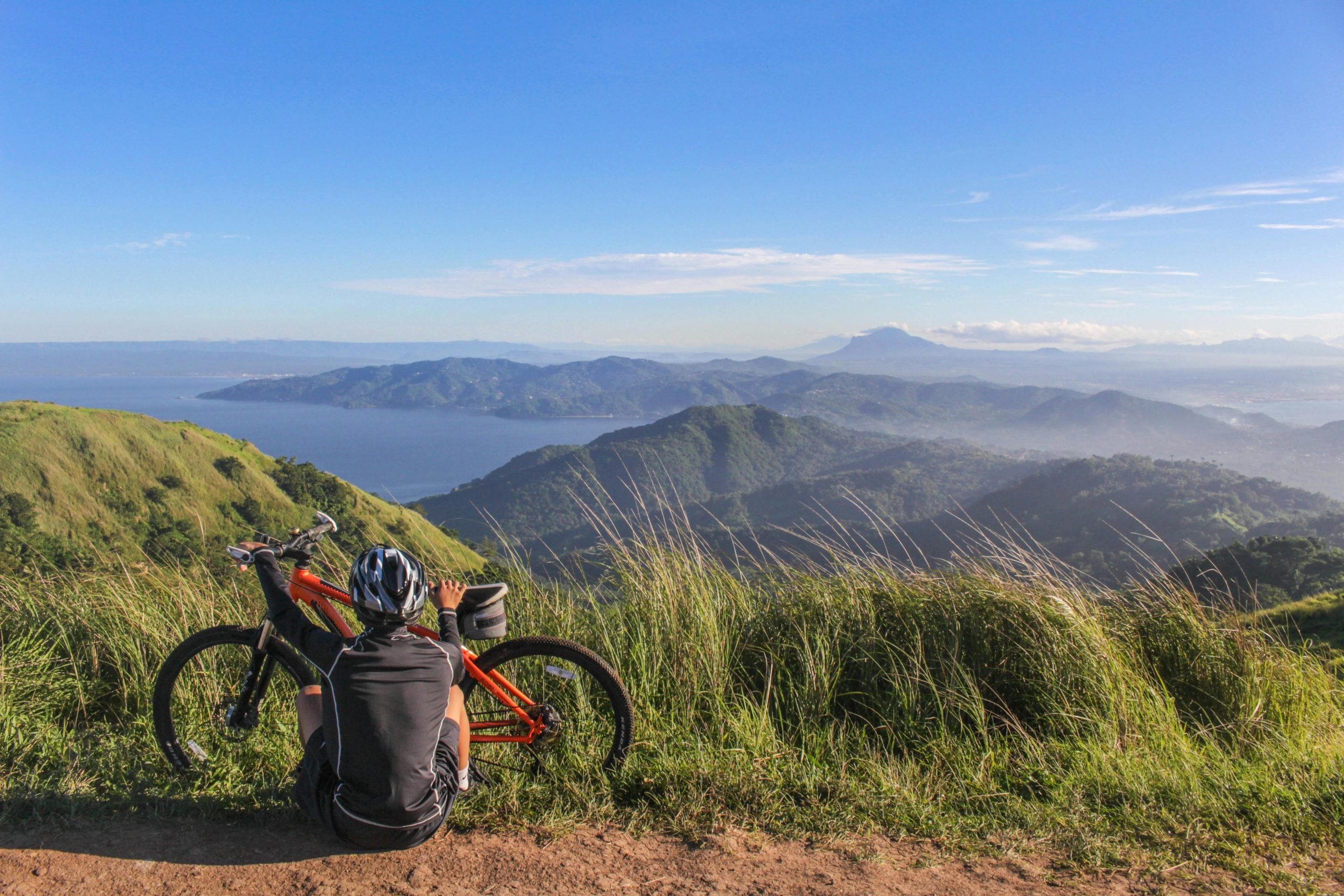10 Best Mountain Bikes You Can Trust in 2024
Our most cherished mountain biking memories include zipping through tree-lined trails, navigating bumpy off-road paths, and tackling muddy routes without a speck of mud on our clothes. These experiences are further enhanced by the company of our biking friends and the reliability of a great mountain bike. After all, the right tools can truly make your day!
However, when we are talking about mountain bikes, it can be very general. Many types of bikes can be referred to as mountain bikes. You may think of hardtails, full suspensions, cross country, trail, enduro, and downhill models. But these “terms” might scare you out especially if you’re new to the sport. Most importantly, they have their own benefits and features that you should be aware of before buying your mountain bike. That’s why today we’ve made this mountain bike buying guide for you.
We’ll walk you through our cherry-pick mountain bike that you can trust in 2024. But to be honest, there is no such a thing called “best mountain bike”. Only the best mountain bike for you, the one that fits your biking style among all these types of mountain bikes. Imagine the thrill of receiving your new bike, unable to resist taking it out for a spin on the trail—this excitement is what we call experiencing THE best bike. Hence, we’ve put together a top 10 list of mountain bikes.
Our guide covers almost everything a mountain biker should know, catering to everyone from beginners to seasoned riders. We’ve included budget-friendly options for first-time buyers just dipping their toes into mountain biking, as well as advanced full-suspension trail bikes capable of handling rugged terrains, not to mention e-mountain bikes and fat bikes. There’s truly a bike for every rider on our list.
Best Mountain Bikes
- Best Overall Bike: Switchblade Pro X01
- Best Mountain E-Bike: Instinct Powerplay A30 Deore
- Best Budget Mountain Bike: TRIFOX
- Best Hardtail Trail Bike: Santa Cruz Chameleon
- Best enduro mountain bikes: SB140 CLR GX Eagle
- Best downhill mountain bikes: SB165 C2 GX Eagle
- Best Short-Travel Trail Bike: Tallboy
- Best Mid-Travel Trail Bike: Instinct Carbon 30
- Best Aggressive Trail Bike: Altitude Alloy 30
- Best XC Bike: Pivot Mach 4
What You Need to Consider Before Buying a Mountain Bike
Where to buy a mountain bike
If you’re in the market for a mountain bike, you’ve got plenty of options, both online and in-store. Starting with local bike shops, these are often the go-to spots for purchasing a mountain bike. Here, you can get hands-on help from knowledgeable staff who can guide you in selecting a bike that fits your needs and budget. Plus, you get the added benefit of supporting local businesses. When visiting a bike shop, don’t hesitate to ask about test rides, bike fitting services, and any upcoming sales.
Online marketplaces and specialized sports retailers are also fantastic places to hunt for mountain bikes. Websites like Amazon, REI, and Backcountry offer a wide array of brands and models. Online shopping allows you to compare prices and read customer reviews, which can be incredibly helpful. Be sure to check out their return policies and warranty information before making a purchase. However, if you don’t want to assemble it yourself, ask the service and see if the brand has a local store or can have your local bike shop assemble it for you. We recommend online bike shops if you are a seasoned rider or enjoy online shopping and like to assemble the bikes by yourself.
Finally, don’t overlook second-hand options. Platforms like Craigslist, eBay, and local Facebook buying groups can be goldmines for finding high-quality bikes at lower prices. Buying used is not only budget-friendly but also environmentally conscious. However, it’s crucial to know what to look for in a used bike to ensure you’re getting a good deal and a bike in decent condition. If you know about bikes, then you can choose this way, otherwise, we would recommend buying bikes online or at your local bike store.
If you’re a first-time buyer, we recommend reviewing the information provided and browsing online to select bikes available at your local shop. Feel free to test them in person. Remember, there’s no obligation to purchase in-store, especially if you find a lower price online.
Not All Bikes are Mountain Bikes
If you’re new to biking, remember that not all bikes are suitable for mountain biking. Mountain bikes are specifically engineered for off-road riding. In fact, many of the knobby-tired bikes available at large retailers aren’t built for trail riding. Instead, these bikes are designed with frame geometry suited for daily commuting or riding on regular paths, not rugged mountain terrain.
Mountain Bike Design You Should Know
In the past decade, MTB has been innovated dramatically. These innovations include 29-inch wheels and 1x drivetrains, as well as the thru axles and dropper posts and carbon fiber materials. All these changes make our rides smoother, safer, and more fun. Not only that, even from the appearance, there are huge changes. From the steeper sear angles, to slacker head angles and longer reaches. That’s why we have this “longer, lower, slacker” geometry design.
However, this progress has reached a new high and is no longer updated in a mad way. Now the new models update in a minimal design, like Yeti SB140 and XXX.
Today, you can find information in the market about MTB wheel sizes. The 29-inch size is still the norm, with a few brands using 27.5 inches. Larger sizes help roll over obstacles like rocks and roots more effectively, whereas smaller ones are easier for riders to handle on twisty mountain trails. We can see the rise of 27.5-inch models among mountain bike brands, particularly in bike types like trail, enduro, and e-bikes. Brands tend to use a 29-inch wheel at the front and a 27.5-inch wheel at the rear. Why? This is because it can provide a snappier cornering experience and better control on steep terrain due to the larger gap.
As for the components, now brands are using UDH, a universal derailleur hanger. Compared to traditional hanger, they can better withstand the forces and impacts common in mountain biking, such as bumps, jumps, and crashes, reducing the chance of bending or breaking. And most mountain bikes also come with SRAM’s transmission drivetrain. The precise and quick shifting of SRAM’s systems, such as their Eagle 12-speed drivetrains, offers a significant advantage in both competitive and daily mountain biking.
All these changes make mountain biking more enjoyable, whether you’re tearing up rocky paths or cruising over roots, your MTB handles it with ease if you got the right one!
Different Mountain Bike Types
Generally, there are four types of mountain bikes: Cross Country, Enduro, Downhill, and Trail. But you can see other types in the market or blogs online like fat-tired, hardtail, mid-travel, or long and short-travel mountain bikes. These categories are born due to their unique design features like hardtail mountain bike is a type of mountain bike that features a front suspension fork but no rear suspension (hence the term “hardtail”). Fat tired bike (often called fat bike) is a mountain bike that features large and fat tires over 3.6 inches or more. Let’s see the general 4 types of mountain bike and then we will explain more about each best mountain bike we selected.
Cross-Country
If you are new to mountain biking, cross-country might not suit you. Cross-country bikes are for racing on XC or marathons. These bikes are optimized for speed, agility, and efficiency over long distances. Most XC bikes are 29-inch wheels with 100mm to 120mm of suspension travel, which is enough to absorb bumps but maintains a rigid feel for better power transfer. XC tires are narrower than those on other types of mountain bikes, typically ranging from 1.9 to 2.3 inches in width. They have less aggressive tread patterns to minimize rolling resistance.
As race courses have included more technical challenges, the design of these bikes has adapted with slacker head angles ranging from 66 to 68 degrees, steeper seat tube angles, and extended wheelbases. These changes also enable cross-country bikes to handle normal rough terrains like trail bikes.
These bikes are typically used in competitive settings but are also popular with enthusiasts who enjoy long-distance mountain biking trails.
Enduro
Enduro bikes are like brothers of XC bikes. They are for racing as well but focus on excelling in downhill speed rather than climbing. Enduro bikes are designed specifically for enduro racing, which involves timed downhill runs combined with untimed uphill transfer sections.
Unlike XC and trail bikes, enduro bikes usually feature more suspension travel, usually ranging from 150mm to 180mm. This helps in absorbing large bumps and drops, providing stability and control on steep, technical descents. They have slacker head angles from 62 to 65 degrees and longer reaches, which help position the rider’s weight further back from the front wheel. Most enduro bikes come with 29-inch wheels, although some models offer a mixed “mullet” setup, with a 29-inch front wheel for better rollover performance and a 27.5-inch rear wheel for more maneuverability.
Enduro bikes are particularly suited for riders who participate in enduro races or those who prefer downhill tracks but still require a bike that can be pedaled back to the top. They can perform well under extreme conditions, balancing downhill aggression with uphill mobility.
Trail
Trail bikes are the most versatile mountain bikes. This is because they can handle a wide range of mountain biking terrain, from flowing singletrack to challenging technical descents. They are built for the majority of mountain bike trails and are popular for both recreational and more serious mountain bikers. So if you want to go through complex riding route, trail bikes are what you need.
These bikes mostly feature full suspension with travel ranging from 120mm to 160mm. Like XC bikes, 29-inch wheels are common, but 27.5-inch wheels are also popular in trail bikes. The choice often depends on rider preference, with 29ers offering better rollover capability and 27.5-inch wheels providing quicker handling. Their head angles typically lie between 64 and 66 degrees, together with longer wheelbases.
Downhill
You could tell from the name that downhill bikes aren’t for climbing at all. These bikes are built to handle big jumps, drops, rock gardens, and other challenging obstacles found in downhill racing and bike parks.
These bikes feature the most suspension travel, typically ranging from 180mm to over 200mm both front and rear. This extensive suspension helps absorb significant impacts, maintain traction, and provide control on extremely rough descents. Downhill bikes have the slackest head angles, usually between 62 to 65 degrees, and are quipped with powerful hydraulic disc brakes with very large rotors (up to 203mm or more), necessary for controlling high speeds and managing heat.
Most riders use lifts or shuttling to get the top hill and then rush down to enjoy the speed and thrill.
We have a special section for Downhill Riders. Check out our downhill riding zone.
How We Rated and Tested Each Mountain Bike?
Our biking team has over 20 experienced riders and they have been biking on mountain bikes for at least 5 years. So most of the brands or bikes are picked by them and rated by them. Our test riders usually go through grounds from East Coast trails to high-speed alpine descents in Colorado, Utah, and other Rocky Mountain states.
We tested almost everything of each model, from its packaging, and assembling to parking and downhilling and muddy road control. Each bike is pushed into their limits and we what to see what they can do and what they can’t. Also we consider their prices, comfort, value and even maintenance service.
Why You Should Trust Us
Bicyclingland are a paradise for riders to enjoy pure riding. We are a group of enthusiastic bike riders that embrace outside nature with our bikes. And that’s why we believe all the gear, bikes and other accessories reviewed here are reliable. We are young and rebellious yet honest to all the insights shared here.
We might not be famous online but we are determined to bring the best part of the bike world to you. Some of the information is researched online and if you want to contribute to it contact us here.
Best Mountain Bikes Review
Best Overall Bike: Pivot Switchblade Pro X01 Mountain Bike
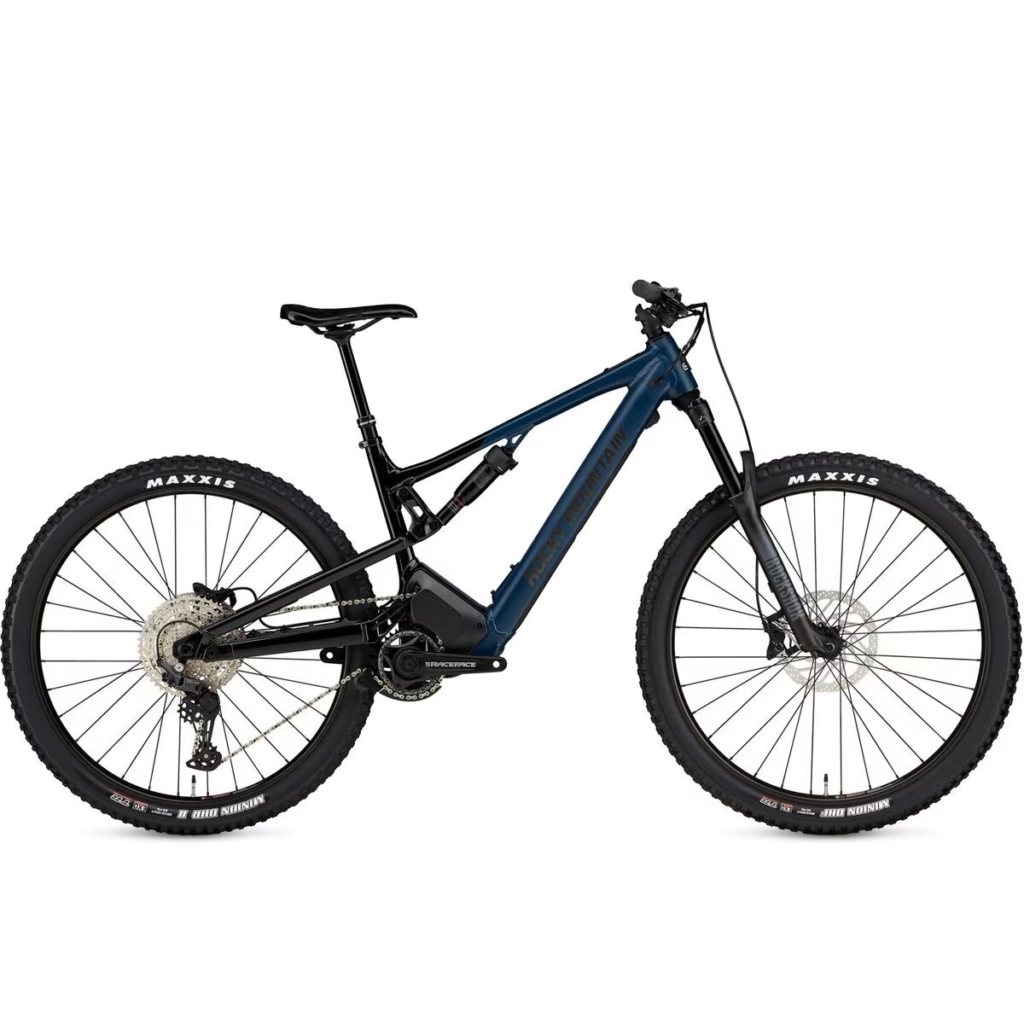
The Switchblade features Pivot’s patented DW-Link suspension design, which provides a stable pedaling platform while still allowing the rear wheel to track terrain accurately. We like this design because this results in a bike that efficiently puts power to the ground, yet remains planted and controlled on rough descents.
At the heart of the Switchblade is a lightweight carbon frame with modern trail geometry. It has a slack 65.6 degree head tube angle for confident descending, along with a relatively steep 75.6 degree seat tube angle to improve climbing traction. The reach is long and the chainstays are short for playful handling.
This top-of-the-line build comes equipped with SRAM’s X01 Eagle 12-speed drivetrain, providing a wide gear range for tackling steep climbs and fast descents. Stopping power comes from Shimano XT 4-piston brakes with 200mm rotors. The suspension features a Fox Factory 36 fork and Float X2 rear shock, offering advanced damping adjustability.
Overall, we think the Pivot Switchblade Pro X01 combines capable trail manners with nimble handling and quality components. Riders who want a high-performance mountain bike suitable for everything from cross-country to bike park riding will find this model hard to beat.
Best Mountain E-Bike: Instinct Powerplay
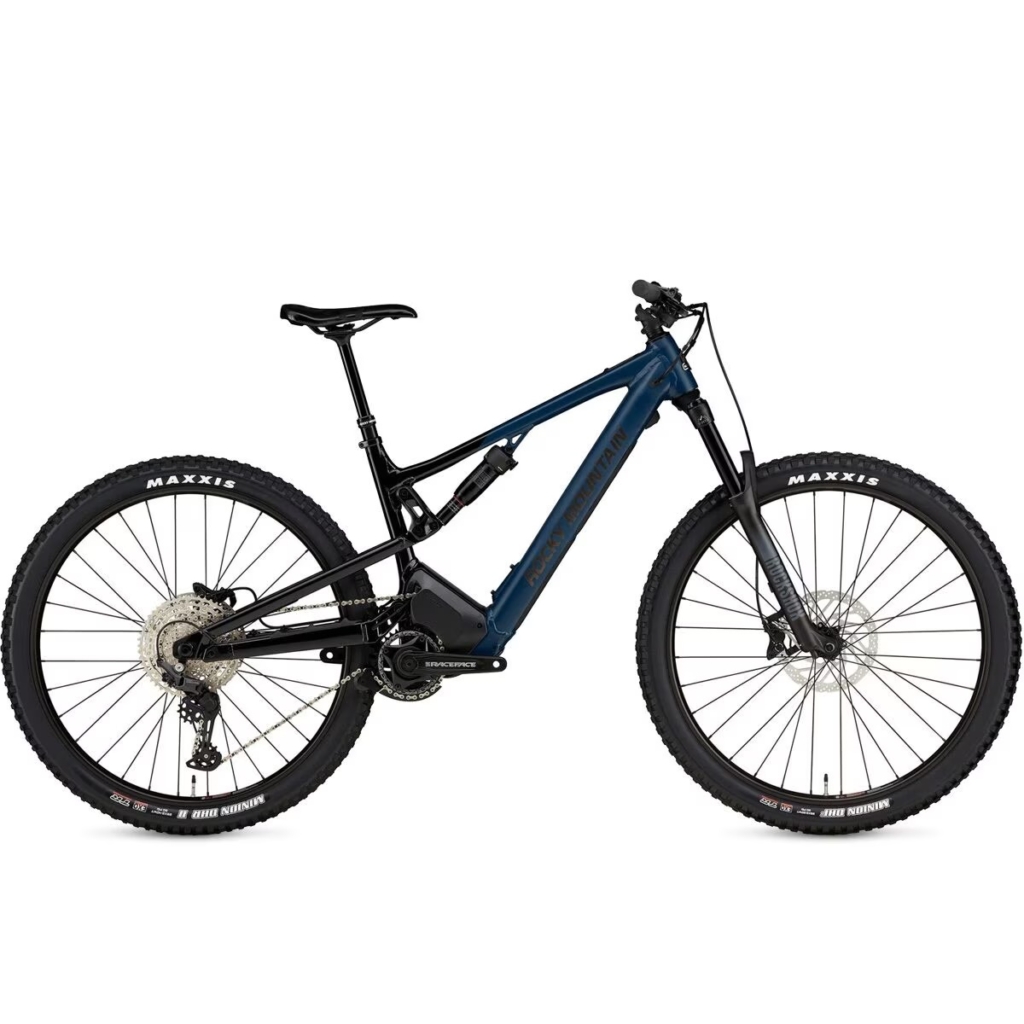
The Rocky Mountain Instinct Powerplay is one of the best electric mountain bikes currently available. This high-performance eMTB features Rocky Mountain’s smooth and efficient Powertrain system with a powerful Brose motor and integrated 504Wh battery.
The Instinct Powerplay has 150mm of front and rear suspension travel from its carbon SmoothLink suspension design. This gives it the capability to tackle even the most aggressive trails with stability and control. The suspension can be fine-tuned using Rocky’s Ride-9 system to adapt it to different riding conditions and terrain.
This e-bike comes equipped with quality components like Shimano Deore brakes and a 12-speed drivetrain. The Powerplay system provides smooth and natural power assist up to 20mph. There are 3 different power modes to customize your ride.
The Instinct Powerplay combines the fun and thrill of a traditional mountain bike with the added power and range from an integrated electric motor and battery system. It’s an excellent choice for riders looking to go faster and further on the trail.
Best Budget Mountain Bike: TRIFOX
The Trifox Mountain Bike is an excellent budget-friendly mountain bike option. This full suspension aluminum frame bike comes equipped with front and rear hydraulic disc brakes for excellent stopping power on the trails.
The Trifox features a high quality SR Suntour XCM fork with 120mm of suspension travel to absorb impacts while riding over rough terrain. The rear triangle suspension design also helps smooth out the bumps. Overall, the suspension provides a plush and controlled ride quality.
This mountain bike is designed with 27.5 inch wheels and wide 2.25 inch all-terrain tires for stability and traction when climbing and cornering. The drivetrain consists of 21 speeds with Shimano Altus shifters and derailleurs, providing a wide range of gears for tackling steep hills.
At this price point, the Trifox hits all the marks for an entry-level full suspension mountain bike. We like its smooth suspension, quality components, and most importantly, excellent value. It’s a great choice for beginner and recreational riders looking for an affordable but fully capable trail bike.

Best Hardtail Trail Bike: Santa Cruz Chameleon

The Chameleon has been a staple in Santa Cruz’s line-up for years. This aggressive hardtail features a simple, single-pivot suspension design mated to a dialed aluminum frame. The latest version of the Chameleon comes in both 27.5-inch and 29-inch wheel versions to cater to different riding styles and preferences.
The Chameleon frame boasts Santa Cruz’s signature construction and attention to detail. The custom butted aluminum provides a stiff, responsive, and lively ride. The frame features internal routing for a clean look and the modern geometry provides confident handling on even the most technical trails.
This trail-worthy hardtail can accommodate both wheel sizes and is designed around short-travel suspension forks from 100-120mm. This keeps the front end nimble while still providing enough squish to smooth out the trail. The Chameleon also utilizes wider boost spacing for added wheel/tire clearance and stiffness.
Overall, the Santa Cruz Chameleon hits the sweet spot of quality, simplicity, versatility, and fun. It’s one of the top hardtail options for aggressive trail and all-mountain riding. The durable frame, dialed geometry, and custom Santa Cruz touches make this a stand-out hardtail in its class.
Best Enduro Mountain Bikes: Yeti SB140
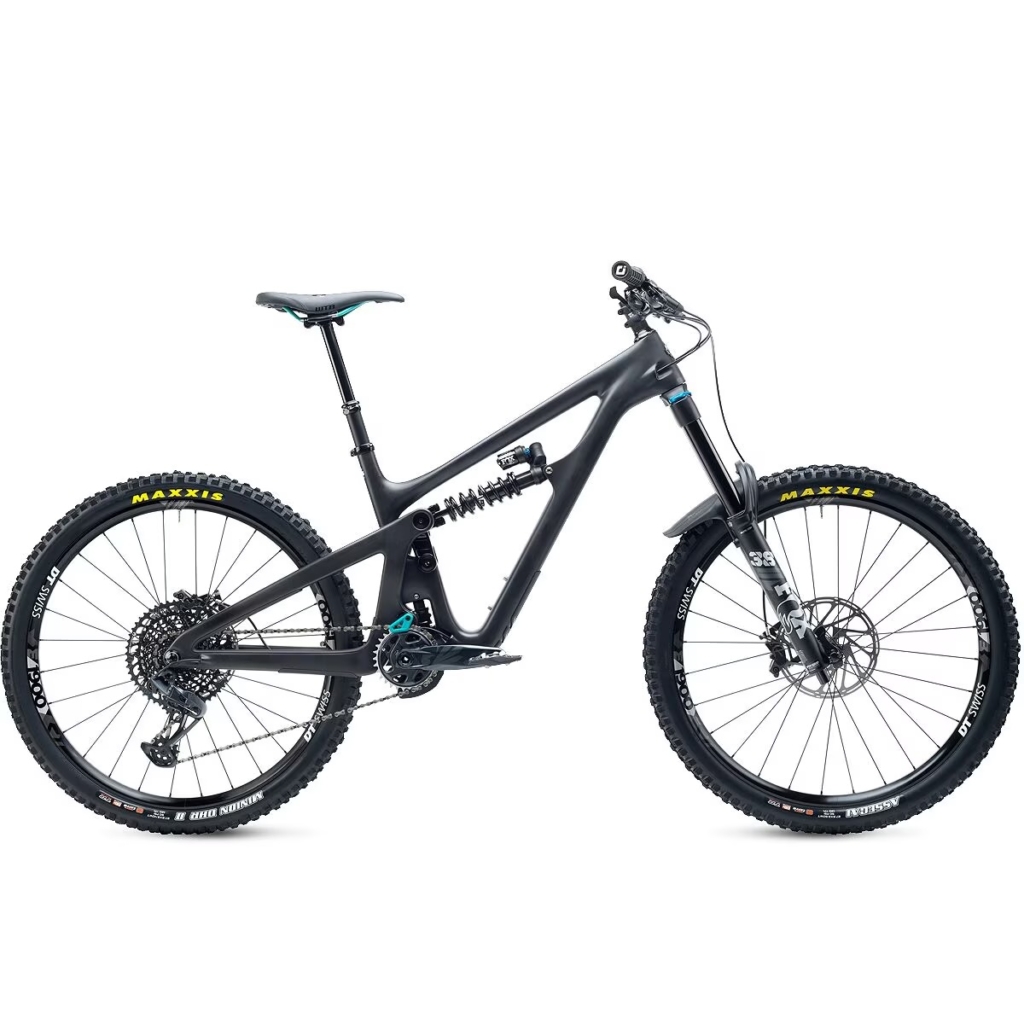
The SB140 features 29″ wheels and 140mm of rear travel, putting it squarely in the long-travel trail bike category. Yeti gave the SB140 a low, slack geometry that makes it an extremely capable descender. It has a 65.4 degree head tube angle in the low setting and a 75.6 degree effective seat tube angle, giving it the stability required for high speeds while still maintaining excellent climbing efficiency.
This bike uses Yeti’s proven Switch Infinity suspension design. This system provides a very progressive suspension curve that allows the rear wheel to move uninhibited while preventing harsh bottom outs. The SB140 soaks up big hits and provides consistent performance through rough sections of trail.
The SB140 frame is constructed from lightweight carbon fiber. The use of carbon keeps the weight quite reasonable for this category of bike, with a complete build coming in around 28 pounds. This makes the SB140 a responsive and lively ride, not sluggish and cumbersome like some long travel bikes.
Overall, with its capable suspension platform, aggressive geometry, and relatively light weight, the Yeti SB140 is one of the top choices for enduro racers or aggressive trail riders looking for a bike that can confidently handle the steepest, most technical terrain. The SB140 blends uphill and downhill performance beautifully.
Best Downhill Mountain Bikes: Yeti SB165
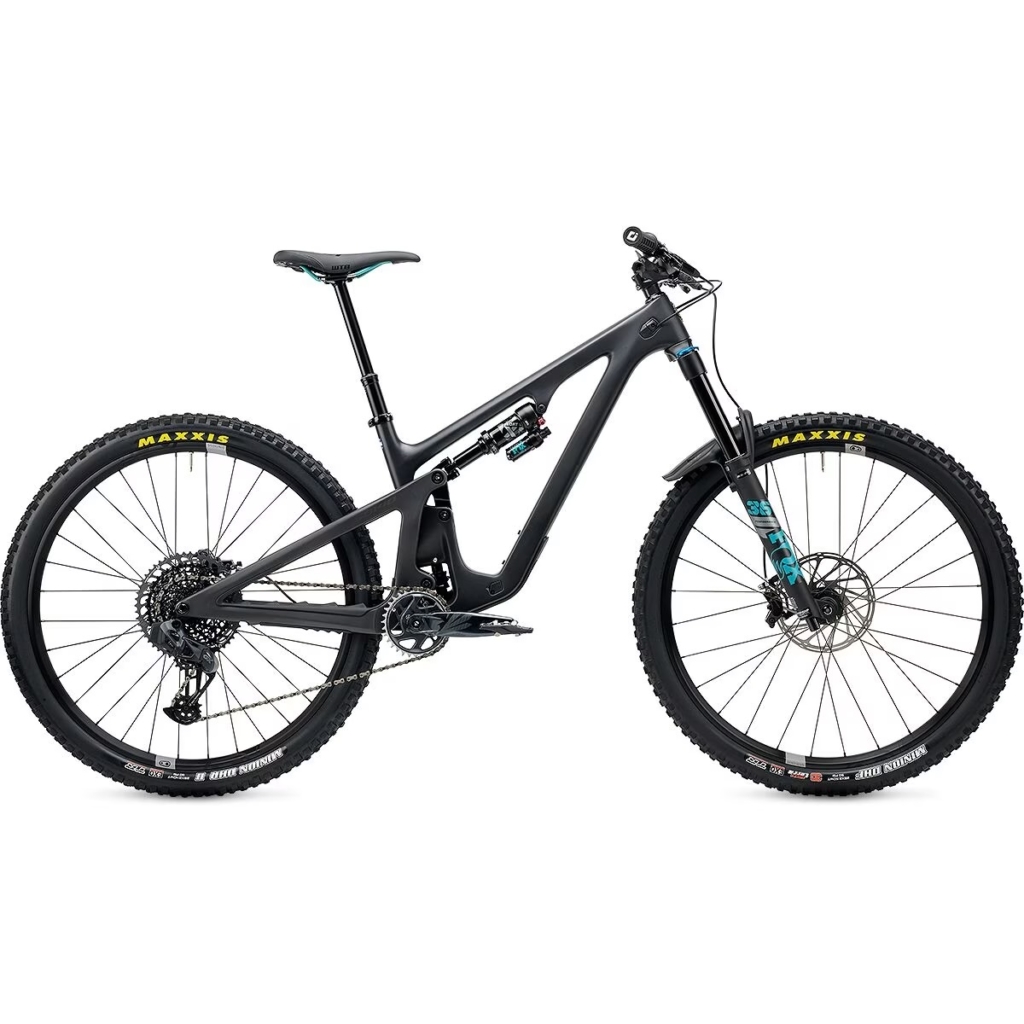
The SB165 features 165mm of rear travel paired with a 170mm fork, giving it the suspension capability to absorb big hits and drops with ease. It has a slack 64.5 degree head tube angle and low bottom bracket height, providing downhill confidence and stability at speed.
This bike utilizes Yeti’s Switch Infinity suspension design. This system has a translating pivot that changes direction as the bike moves through its travel, resulting in a very supple mid-stroke and excellent bottom-out resistance. The SB165 suspension provides a bottomless feel over rough terrain.
The SB165 frame is constructed from carbon fiber, reducing weight while maintaining stiffness and strength. Components are tailored for aggressive downhill riding, including wide rims, beefy tires, powerful brakes, and a 1x drivetrain with a wide range cassette.
Riders praise the SB165 for its capabilities on the steepest, rockiest downhill trails. It’s an extremely capable bike that can handle the jumps, drops, and chunky terrain found on downhill and bike park runs. The SB165 gives riders the confidence to go faster and hit larger features.
Best Short-Travel Trail Bike: Santa Cruz Tallboy
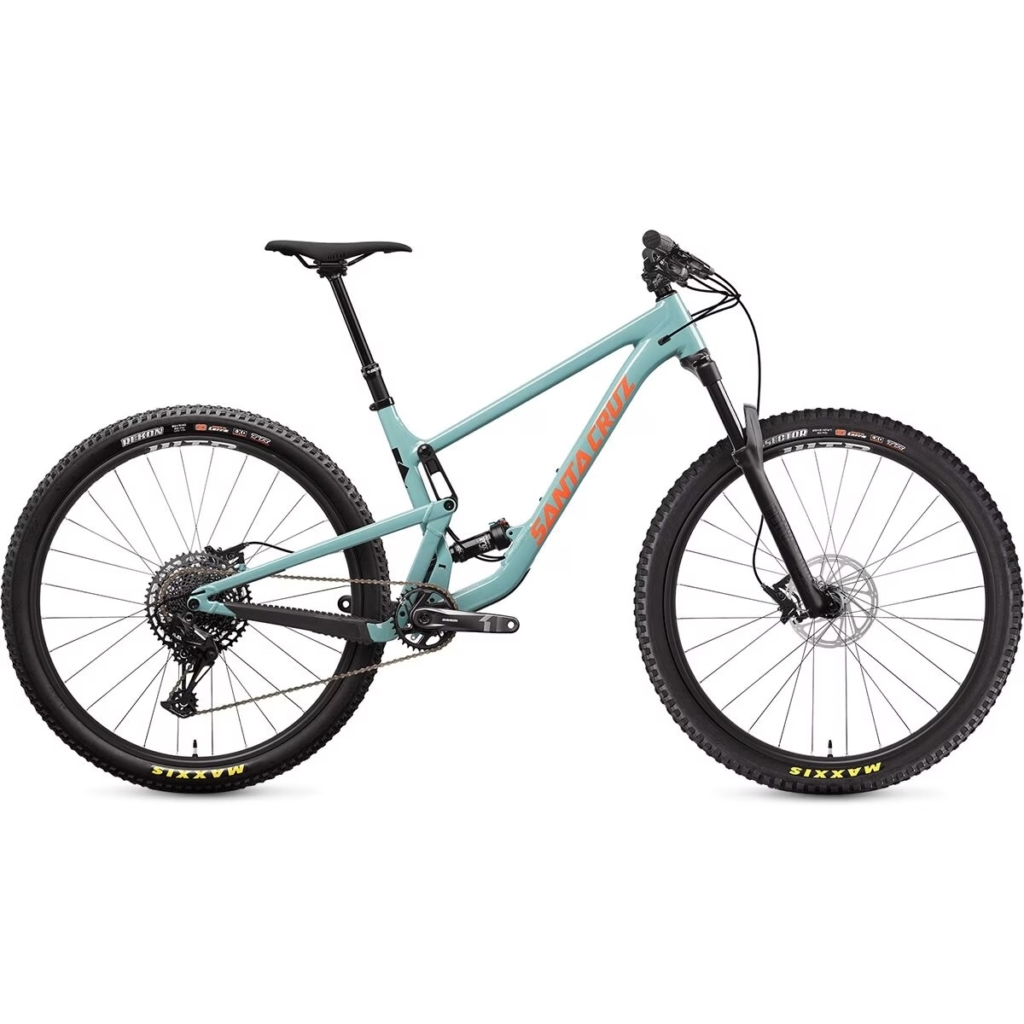
The Tallboy features 120mm of rear travel paired with a 130mm fork. This provides just the right amount of squish to smooth out roots and rocks on the trail. The VPP suspension design offers a very lively and playful feel, making the Tallboy a fun and poppy short-travel bike.
This latest version of the Tallboy has seen some key updates. It now has lower, slacker geometry for added stability at speed and on steep descents. Reach numbers have been lengthened for a more confident feel. The flip chip lets you fine-tune the geometry between a low and high setting.
Another standout is the revised lower-link mounted shock. This gives the Tallboy excellent small bump compliance and sensitivity off the top of the travel. It has a very supple initial stroke that helps maintain momentum over chattery terrain. The bike pedals efficiently and doesn’t wallow under power.
Overall, the Santa Cruz Tallboy hits the sweet spot for an aggressive short-travel trail bike. It’s capable enough for challenging terrain, yet lively and energetic. Riders looking for a fast, nimble steed will love this bike.
Best Mid-Travel Trail Bike: Instinct Carbon 30

With 130mm of rear travel paired with a 150mm fork, the Instinct hits the sweet spot between short travel cross-country bikes and long travel enduro rigs. It’s able to efficiently climb technical trails while remaining composed on rowdy descents.
The Instinct Carbon 30 features Rocky Mountain’s Smoothlink suspension design. This allows the rear wheel to track terrain and maintain traction over chunky sections. The Ride-9 adjustable geometry lets you fine tune the head angle and bottom bracket height to match your riding style.
This iteration comes equipped with a Shimano SLX 12-speed drivetrain, 4-piston brakes, wide rims and a dropper post. Everything you need for attacking trails at speed with control. The modern geometry provides stability and maneuverability through tight switchbacks and fast curves.
Overall, the Instinct Carbon 30 is one of the top picks for aggressive trail and enduro-style riding. It blends efficiency, capability and fun into a balanced package ready to rally. If you want a bike that can climb well and charge downhill at speed, the Instinct deserves a close look.
Best Aggressive Trail Bike: Altitude Alloy 30
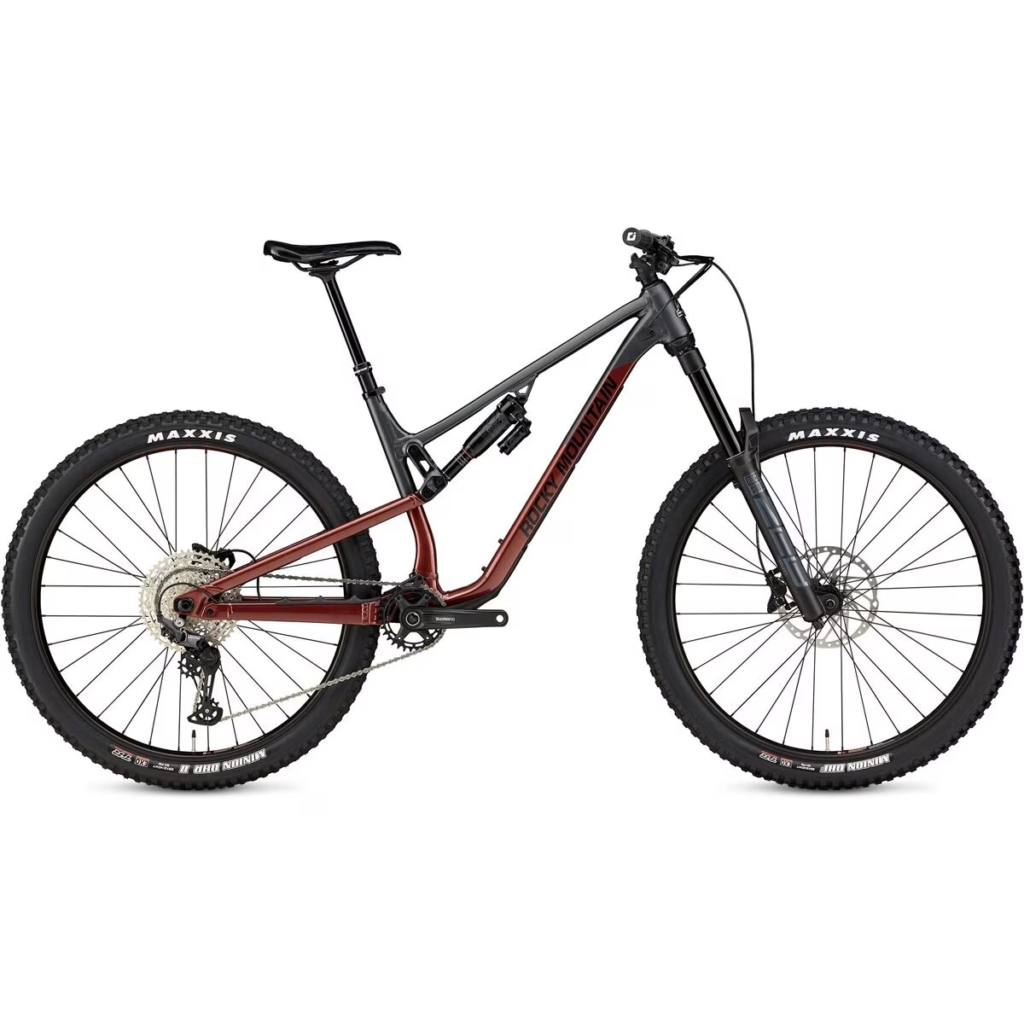
The Rocky Mountain Altitude is a standout as one of the most fun and aggressive trail/all-mountain bikes currently available. This capable rig can confidently tackle even the most demanding trails with its balanced geometry and quality component specification.
The Altitude lives up to its name and begs to be ridden hard and fast on steep, technical terrain. It has a very capable frame with 150mm of rear travel paired with a 160mm fork upfront. This provides a slack head tube angle for confident descending along with a reasonable 74.3° seat tube angle for climbing efficiency.
This bike comes set up with quality components like a Fox 36 Performance Elite fork, Fox Float X2 rear shock, SRAM Code R brakes, Race Face AR 30 rims, and Maxxis Minion DHF/DHR2 2.5″ tires. This is a very robust spec that can handle hardcore enduro racing as well as aggressive trail riding.
The Altitude’s geometry, suspension design, components, and attention to detail make it one of the most capable and confidence-inspiring aggressive trail bikes you can buy. Riders looking for a bike that excels at charging steep, rough terrain will love this Rocky Mountain model.
Best XC Bike: Pivot Mach 4 SL

Its carbon fiber frame is not only lightweight at 21.5 lbs but also remarkably responsive and efficient. This makes climbing and descending both seamless and enjoyable.
The bike’s suspension system is another highlight. With 100mm of rear wheel travel from the DW-Link suspension design, it adeptly maintains momentum over rough terrain, keeping the wheel in contact with obstacles for consistent speed. The Fox Factory 32 Step-Cast fork complements this with another 100mm of front travel, adding to the bike’s precise handling capabilities.
Equipped with a SRAM XX1 Eagle 12-speed drivetrain and a wide 10-50t cassette, the Mach 4 SL offers a versatile range of gears. This setup ensures smooth shifting and a perfect gear for every slope and speed, which is crucial in both races and rugged trail rides.
The combination of carbon fiber rims and Maxxis Aspen tires not only reduces weight but also enhances the bike’s agility and acceleration. Being tubeless-ready is a significant plus, allowing for lower tire pressures and fewer punctures, which translates to better traction and a smoother ride.
In summary, the Pivot Mach 4 SL is an exceptional choice for competitive XC riders. It expertly blends lightweight construction with robust performance capabilities, making it ideal for racing and serious trail adventures alike. Its top-notch suspension, precise handling, and high-quality components position it as a formidable contender in the XC category.
